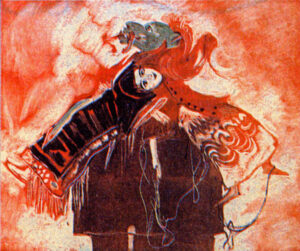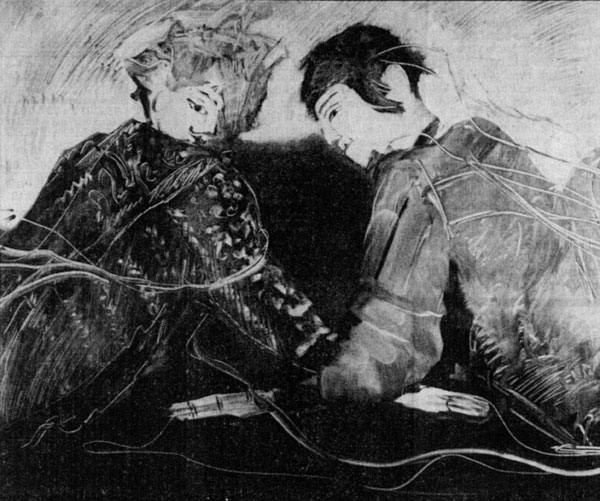NINA BOHLEN
by Philip Isaacson
Maine Sunday Telegram, August, 1993

The name Nina Bohlen calls to mind Boston of the late 1950s and early 1960s. Although she was then a young woman, her name is linked in my mind with Hyman Bloom, Harold Tovish, Hyman Swetzoff, Boris Mirski, George Lockwood and Stuart Denenberg, all of whom I knew rather less than more. I won’t try to sort the list out, but it includes painters, sculptors, gallery owners and printmakers who in the recesses of my thoughts fuse into a corps. They were not, in fact, a group. I don’t know whether they even liked one another, but each created or urged a kind of art that draws the greatest allegiance from me.
It is an art that penetrates the human carcass, pushes through its sack of bone and guts, past filth and corruption, past the certainty of death, to prop up the human spirit. It is gloomy, and the spirit it reaches is corroded and bent, but it is not an art of despair. It prophesies that, in the end, we will survive both the limitations others impose on us and those we impose on ourselves.
Those were the best of times for Boston, and, as I say, during them Nina Bohlen was a recurring name. Her work was shown at the Swetzoff Gallery and at Deneberg’s Tragos Gallery. She studied painting and drawing with Bloom, sculpture with Tovish, and so on. From time to time I would see a drawing of hers or perhaps a painting or two, but not in much quantity. I would have had to go to the Martin Summers Gallery in Manhattan for a major show of Bohlen’s work and I never did. However, a current exhibition in Georgetown has made such an expedition less essential.
The Anne Weber Gallery, one of my longstanding enthusiasms, has reopened, albeit for the sole purpose of a short show of Bohlen’s work. The exhibition consists of about 24 monotypes and some drawings. They span 1984 through 1991, with the latter date being the most fully represented.
There are a few landscapes and one or two likenesses of birds, but the body of work depicts features and attitudes taken from a collection of puppets. As puppets on a stage serve as surrogates for humans, so they do in Bohlen’s prints. But they do more. They also stand for physical beauty, and Bohlen’s models are both touching and very beautiful. They come from Burma, Indonesia and, perhaps, China and India, and they are ephemeral. Made of cloth, sticks, bits of painted wood and perhaps paper, they are as visually fragile as a kite. And they suggest that they will be short-lived.

Monotype is an ideal medium for defining puppets. A species of print that contradicts the definition of a print – multiple impressions – it is limited to a single strike and even that is as frail as a watercolor. Light struggles from within it and lifts the pigments from the sheet. To the eye, it is as impermanent as volatile as the string, the thin wooden rods and the softly carved heads of the figures. Monotypes are quickly made and not quite predictable, and puppets are full of spontaneity and surprise. Bohlen’s figures float in an enchanted space. There is a suppressed incandescence to the colors in which they exist. It is as though they were once sharp with color and now those colors are beginning to vanish.
But as compelling as they are, the puppet images are only a point of departure. They take on attitudes that qualify as metaphors, particularly metaphors for the relationship between human couples. Titles such as “Reclining Puppets,” “Elegant Burmese Puppet,” “Separate Ways” and “2 Resting Burmese Puppets” suggest the roles the puppets represent.
Their range of conduct is deeply considered by the artist and is limited only by our willingness to observe and our imagination. Through fantasy and in beautiful and figurative terms, Nina Bohlen has begun to catalog human conduct. It is a heart-touching performance.